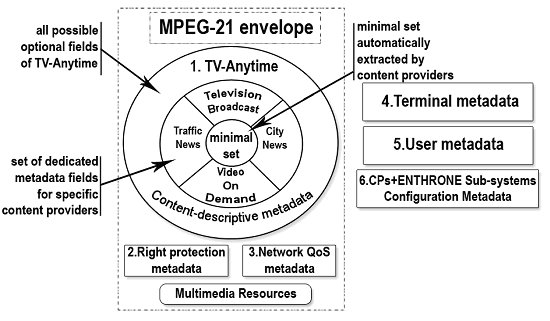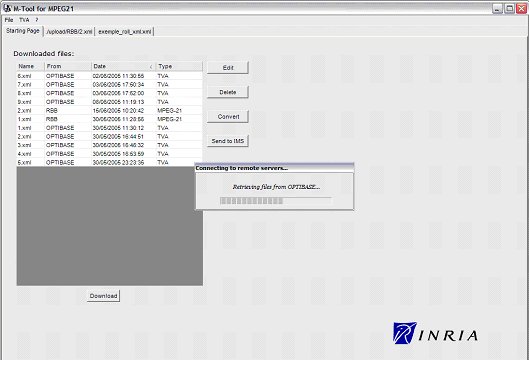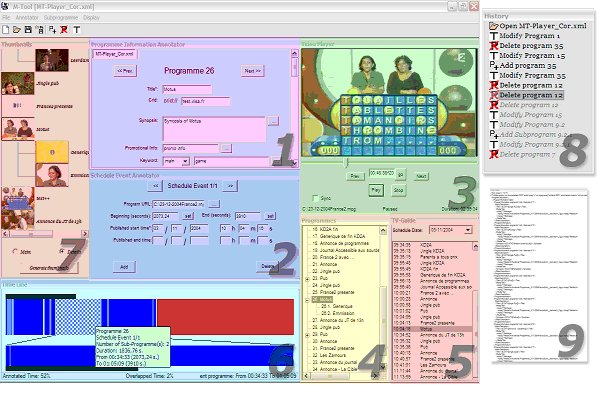
|
Metadata authoring tool for multimedia and audiovisual resources descriptions
An innovative metadata authoring tool using a unified model based on MPEG-21 and TV-Anytime standards
Developed by Boris ROUSSEAU, Wilfried JOUVE
and Laure Berti-Equille
For more information please contact us at: boris.rousseau@irisa.fr / wilfried.jouve@labri.fr
Or consult the technical documentation
|
Overview:
The M-Tool
(or Metadata Autoring Tool) is a prototype application running on Windows platform
developed with the .Net Framework and Windows Media Player. Its objective is
to allow content producer to annotate as well as visualise and navigate through
multimedia and audiovisual resources repositories. The idea behind it is to provide
one single tool for content producers that present a mixture of textual, graphical,
and audio/video data. This page presents the work achieved in the European Integrated
Project ENTHRONE.
We will greatly appreciate your feedback; although the M-Tool is still in development, your comments,
ideas or critics will help us to improve this tool.
Main Functionalities:
The M-Tool
is a prototype multimedia authoring tool that federates metadata generation
for a diversity of content formats. We consider that a single application to
create or enrich metadata will achieve interoperable and transparent access
to multimedia resources from any type of client terminal or network and provide
an implementation to the Universal Multimedia Access (UMA) concept. It
makes use of a unified model based on the MPEG-21 and TV-Anytime standard specifications
to enable content description, transport, adaptation and Digital Rights Management
(DRM).
TV-Anytime and MPEG-21 are complementary and
cover the requirements specified by the ENTHRONE partners for Video
on Demand (VoD), TV broadcast, and News broadcast
scenarios. Our point of view is that the use of MPEG-21 adds
the flexibility mandatory to adapt to these various
services and situations. MPEG-21 enables the
hierarchical representation of multimedia contents
which is useful to create advanced and interactive
multimedia contents. Every resource is described using
the TV-Anytime standard and then, resources are
gathered and synchronized inside a MPEG-21 structure
that includes network QoS and adaptation metadata
and right protection metadata.
Figure 1 illustrates the metadata description schema.

Figure
1. Metadata model in the ENTHRONE project
Graphical User Interface:
The M-Tool is a prototype that offers the functionalities required to create
or manage metadata information relevant to a particular resource. The aim of the GUI is to provide the
end-user and service providers with modules that enable creating, enriching, browsing, maintaining
and monitoring content-descriptive metadata.
In the ENTHRONE overall architecture, the M-Tool is located in the Metadata Management Module that collects metadata
from all content providers, enriches, processes and sends it to the database.
Figure 2 illustrates ENTHRONE overall architecture with the relevant partners' name.

Figure 2. Metadata management architecture and orchestration
Communication Interface:
This acts as
the input to the Metadata Management Module in that it allows downloading metadata
documents from various input sources provided by Content Providers. When a user
requests to download a TV-Anytime or MPEG-21 document from content providers,
the M-Tool invokes available remote servers to check whether TV-Anytime metadata
could be retrieved. If so, the metadata document is downloaded (via an HTTP
Get or a SOAP get request). As shown in figure 3, the content producer is allowed
to edit, delete, convert or send the relevant document to the database.

Figure 3. M-Tool communication interface
This tool provides the functionalities to edit and visualise both MPEG-21 and TV-Anytime metadata documents through the respective modules.
M-Tool for MPEG-21 (Figure 4):
The M-Tool for MPEG-21 is a DID editor and generator. The generation of the
DID structure is achieved thanks to a graphical representation of the MPEG-21
structure. The user can drag and drop relevant icons to add MPEG-21 structure elements (Container,
Item and Component) or descriptor elements (TVA schedule event, TVA program
information, REL and DIA metadata and Free Text). A DID is edited or generated
by inserting/deleting or modifying these elements inside MPEG-21 descriptor.
M-Tool for TV-Anytime (Figure 5):
The M-Tool for TV-Anytime has functionalities to load, annotate, enrich or create a new TV-Anytime
document while keeping any edition compliant with the schema and in synchronization with the audiovisual resource.
It could be executed as a standalone application and is composed of two main modules: the configuration module
and the TV-Anytime editor itself.
The configuration module allows user to select relevant TVA fields depending on their requirements for
annotation. The M-Tool actually enables users to choose between over 90 TVA fields (e.g. genre, parental
guidance, audiovisual attributes, etc) to adapt the annotation areas to the selected elements.
The Annotator is a form consisting of several editable fields as requested by the user with
the configuration module and taken from the profile. The annotator is divided into two sections:
Program Information and Program Location of the current program as shown in the above
figure. As for the TV-Anytime specification, Program Information describes the resource in terms of title,
synopsis, keywords, etc whereas Schedule Event represents a single instance of a program schedule or availability.
The same program can be shown several times within the same day; as a result the same description can point
to several schedules. The annotator supplies functionalities to edit, delete and add programs, Schedule Events or subprograms
associated with the actual resource.
|

Figure 4. M-Tool for MPEG-21 user interface
|

Figure 5. M-Tool for TV-Anytime user interface
|
The M-Tool is currently being tested and integrated in the ENTHRONE demonstrators.
Perspectives:
We are considering
using this tool in conjonction with Navitex
and the team's
video on demand platform to develop a full text and possibly content based
search engine.
Last update - october 2005





